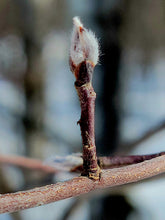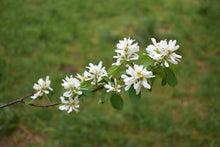
Amelanchier alnifolia
Western serviceberry, also known as saskatoon, is a silver-barked large shrub or multi-stemmed small tree that is beloved equally by gardeners and wildlife. Each spring, it becomes covered with fragrant, white, 1” flowers that supply food for native bees, hummingbirds and butterflies. By summer, the flowers transform into edible reddish berries that eventually turn black when ripe. The berries are delicious, good for jellies, and high in vitamin C, manganese, magnesium and iron - but good luck getting any because they are adored by robins, chickadees, tanagers, and waxwings. Its attractive bluish-green leaves also provide food for many types of butterfly larvae and, in sunnier sites, they will reward you with autumn colors.
- Plant type/canopy layer: deciduous, perennial, small tree/large shrub
- Size at maturity: 4-12' tall
- Light requirements: full sun to part sun
- Moisture requirements: dry, moist to seasonally wet soil
- Bloom time: March - August (April - June in the Portland Metro area)
- Growth rate/ease: slow growing, easy to grow
- Wildlife support: flowers attract and provide nectar to hummingbirds, adult butterflies, bees and other insect pollinators; berries are eaten by 21 species of local birds and five mammals; overall plant attracts and supports beneficial and other pest eating insects and is a host plant and larval food source for native butterflies and moths
- Native habitat/range: common in open meadows, woodlands, streambanks and conifer forests at low to mid elevations from Alaska to California, and across Great Plains into eastern Canada. Portland Plant List - yes.
- Special features & uses: edible and highly nutritious berries; pollinator powerhouse; medicinal; landscape uses include habitat hedgerows, windbreaks, and erosion control
What to Expect + Gardening with Western Serviceberry: Serviceberry prefers full sun to partial shade, and tolerates a wide range of soils - but not heavy clay. They can be quite drought tolerant once established and do best without a lot of root competition - so space them apart from other plants if possible. They are an excellent addition to a native hedgerow, windbreak, thicket, or erosion control planting in your woodland garden. Consider growing serviceberry with associate plants like Oregon white oak, Douglas-fir, Oregon grape and birch-leaved spiraea.
On the downside, please be aware that western serviceberry is susceptible to cedar rust, which has become widespread in the region. Cedar rust is transmitted by fungus spores from nearby cedars and junipers and causes bright orange spots on the plant. Avoid planting near cedars or junipers. Remove and dispose of any leaves displaying rust as soon as possible and avoid watering the leaves if the fungus is present, as it will drip down and spread (only water at the base). This fungus is almost always merely a cosmetic concern (and a minor one at that), later in the season, well after the flowers have finished.
Photo Credits 1: © Wendy Feltham, some rights reserved (CC-BY-NC)
Photo Credit 2: © Séraphin Poudrier, some rights reserved (CC-BY-NC)
Photo Credits 3 - 7: Nikkie West, Sparrowhawk Native Plants
Photo Credit 7: "Serviceberry (Amelanchier alnifolia)" by GlacierNPS is marked with Public Domain Mark 1.0.















